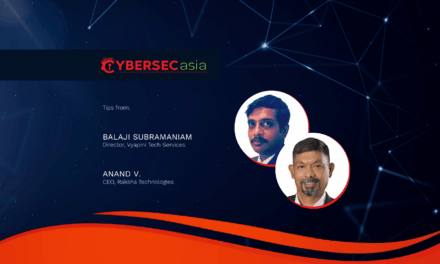Explore actionable strategies and forward-looking ideas for financial institutions to thrive — while building resilience, managing risks and embracing growth.
From AI-powered services and Blockchain 2.0 to the rise of embedded banking, the first half of 2025 has demonstrated one thing: financial institutions (FIs) are no longer resisting disruption — they are driving it.
As innovation accelerates across the global sector, particularly in areas such as Cards-as-a-Service and Islamic finance, the race toward digital transformation is in full swing. Yet, with widespread transformation comes risk. Nearly half of cybersecurity breaches now stem from third-party vendors, and as FIs become increasingly reliant on external partners in their bid to innovate, cracks are beginning to show.
Disruption without discipline is dangerous. So moving forward, how can FIs future-proof their digital foundations so they can stand as fortresses instead? Mathias Faure, Chief Product and Technology Officer, audax interacted with CybersecAsia to provide some insights.
Amid growing white spaces for FI growth ahead, are fault lines beginning to show in the recent fintech innovations in H1 2025?
Mathias Faure (MF): Indeed, the white space for FI growth is growing. As financial technology enters a measured phase of maturity, the focus is shifting from breakneck disruption to sustainable innovation.
Several key growth opportunities are evident for the latter half of 2025:
- AI-powered features: A prominent white space is the expanding adoption of AI-driven solutions, including automated customer service, predictive analytics for financial insights, and tailored marketing offerings.
- Embedded payment solutions, lending, and insurance: We see another area for growth in the presence of seamless embedded payment systems across sectors such as travel, real estate, and gig economy platforms, featuring integrated Buy Now Pay Later, real-time payouts, and co-branded payment cards, transitioning from add-ons to defaults. Likewise, broadening embedded financial services directly within e-commerce and digital service platforms to enhance convenience, improve customer engagement, and boost transaction completion rates. These emerging features will offer end users within interoperable and intelligent systems that can boost transaction completion rates and scale across ecosystems without added complexity.
- Stablecoins as legitimized payment instruments: Both the US GENIUS Act and the EU’s MiCA regime are transforming what were once shadowy stablecoins into fully supervised payment instruments.
- Reaching the underbanked: Another white space is in scaling inclusive finance for underserved markets. Technology is enabling FIs to offer a complete “paperless” onboarding experience using advanced automation, including AI, biometric facial recognition and E-KTP validation. By removing the need for in-person bank visits or physical documentation, this model lowers barriers of entry for unbanked individuals and microbusinesses. This model can be replicated across underserved markets worldwide.
AI innovations have dramatically reshaped customer experiences through personalized financial management, sophisticated fraud detection mechanisms, and generative AI-driven tools. Embedded finance and even insurance has notably accelerated. These developments have significantly enhanced user interactions and created substantial new revenue streams.
Fintech players are positioned to support opportunities through integrated tools that streamline adoption and foster innovation. Digital platforms of this kind continue to advance analytics and AI-powered features such as automated financial recommendations and adaptive risk assessment tools. The adoption of “compliance as code” is enabling regulatory controls to be seamlessly documented, integrated, and evidenced in real time, thus securing trust from regulators and stakeholders alike.
However, this acceleration comes with risk. As FIs adopt platform-based models and integrate third-party systems, they are also decentralizing control. According to a gamut of industry surveys, nearly half of cybersecurity breaches now stem from supply chains, and some 80% of organizations polled had experienced at least one third-party data breach in the last year.
Beyond cybersecurity, the rapid pace of integration is revealing regulatory gaps and increasing architectural complexity, reinforcing the need for robust Banking-as-a-Service platforms that ensure regulatory compliance and simplify ecosystem-wide integration.
In short, innovation is no longer the only imperative: resilience and governance need to evolve in parallel. FIs should embed security at an infrastructural level to avoid trading speed for systemic risk.
What are the established ways to embed security and fraud prevention into the infrastructure itself, rather than treating them as Band-Aids?
MF: As digital ecosystems mature, there is a growing consensus that security and fraud prevention must be built into the core, not patched on. The goal now is clear: move from risk mitigation to security by design.To do this requires preemptively embedding protection from the earliest stages of development.
Financial institutions can leverage AI to accelerate this transition on two key fronts: continuous monitoring and advancedauthentication. Deploying proactive AI monitoring helps in detecting and neutralizing threats in real time, slashing false positives and cutting resolution times from hours to minutes.
Meanwhile, adaptive authentication methods, including biometric verification, strike the balance between security and frictionless user experience — critical in an era where customers routinely access multiple digital services.
Yet, as banks and FIs modernize, there is a real temptation to adopt AI for the sake of novelty. We believe that practical AI adoption: integrating it directly into our infrastructure, where it delivers tangible value. With this approach, FIs can have the peace of mind that their operational environment is well secured.
By layering these critical principles of security by design, real-time monitoring, and intelligent authentication, FIs can build security systems that do more than protect — they unlock innovation from within and support sustainable growth in an increasingly complex digital landscape.
With industry acceleration towards a more interconnected and intelligent future, what can financial organizations in the region do to reimagine agility, resilience, and competitiveness?
MF: As the financial ecosystem becomes more interconnected, agility and resilience must become structural features, not surface-level fixes. FIs need to rethink how they operate, collaborate and adapt in a space where disruption is constant and new entrants, continuous.
To remain agile, resilient, and competitive, financial organizations should:
- Embrace open and flexible architectures: Leverage open APIs and modular system designs to enhance rapid integration and scalability.
- Cultivate agile talent and culture: Agility starts with moving away from siloed structures. Leading institutions have begun forming cross-functional product teams that promote innovation-driven cultures and enable more agile methodologies for swift adoption of market demands and technological advancements.
- Foster strategic collaborations: Resilience is built through ecosystem co-creation. Rather than purely outsourcing capabilities, FIs should rewire their relationship with fintech startups, technology providers and regulators to be more partnership-driven — engaging proactively to jointly develop cutting-edge financial solutions.
Ultimately, staying competitive in an intelligent financial system will mean replacing legacy mindsets with data-driven strategy and rewiring partnerships for shared speed and innovation in the years ahead.

















